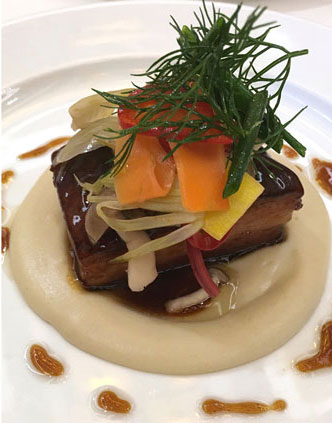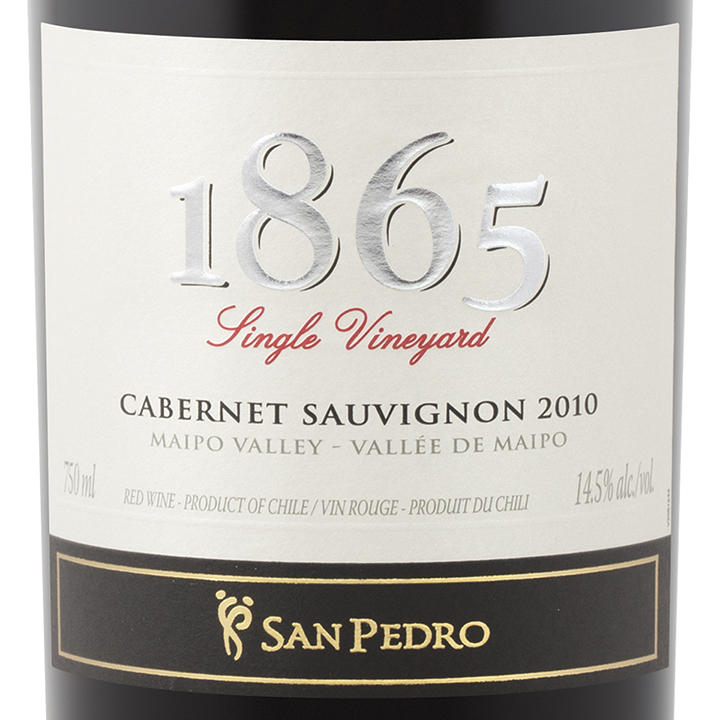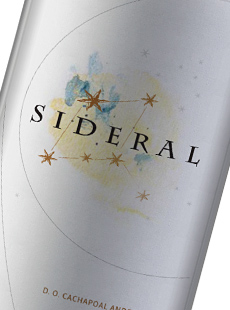For the past two weeks, we’ve been looking at some of the basics that show how wine and food go together by digging in to the wine pairings featured at the interactive dinner at the “Spring Edition” of VeritageMiami.
The third course of the night was a very complex dish created by chefs Brad Kilgore of the restaurant Alter and Alex Chang of The Vagabond. I had to laugh when they told me they wanted to make this dish: somehow two chefs managed to come up with a dish in four parts. We ended up with a heavily seasoned and cured pork belly that was then braised, and then pan-seared and then glazed with salty Japanese umeboshi plums. This chunk of tart, slightly salty protein was then placed on a bed of turnips puréed with an umami-laden Japanese cooking stock called dashi plus the Spanish garlic and almond soup called ajo blanco. And as if that were not complicated enough, the dish was topped with some pickled vegetables.
 Umeboshi-glazed Pork Belly with Dashi-poached Turnip and Ajo Blanco Purée and Pickled Vegetables (Photo: VeritageMiami)
Umeboshi-glazed Pork Belly with Dashi-poached Turnip and Ajo Blanco Purée and Pickled Vegetables (Photo: VeritageMiami) As complicated as this dish is to describe, the final result was a surprisingly harmonious dish in which all the elements balanced out, and it provided an interesting experiment in wine and food pairing because the dish included all five of the principal tastes that affect wine: salty, sweet, sour, bitter and umami. And what does this tell us about a wine choice?
I think the key thing to note at first is that salt plays a significant part in the dish. The pork belly is cured in salt before a long, slow braise in chicken stock. This reduces the saltiness of the pork, but then, when it is cooked, the pork is glazed with salty umeboshi plum, brown sugar and vinegar, bumping the saltiness and the sourness back up. Salt in food moderates tannin and bitterness in wine, so this preparation is a license to pull out a tannic red wine. Acidity in food, which we get here from the umeboshi glaze as well, tends to make wines softer (you can test this for yourself by tasting a red wine at dinner, then lick a lemon and taste the wine again – it will seem sweeter and softer).
Umami is that elusive “fifth taste” that is often described as “deliciousness” or “savoriness” because there is no word for word translation of umami from Japanese to English. It may be elusive to describe but it has an impact on wine – umami, which we find in mushrooms, soft cheeses and smoked meats among other items, makes wine taste less sweet, and less dense, and it increases our perception of bitterness and acidity in wine. We had a moderate amount of umami in this dish from the seaweed-rich dashi that was part of the turnip purée, and from the curing of the pork belly.
 1865 Single Vineyard Cabernet Sauvignon (Photo: Viña San Pedro)
1865 Single Vineyard Cabernet Sauvignon (Photo: Viña San Pedro) So, we have salt and sour in our dish to decrease our perception of bitterness and increase our sense of sweetness in the wine, and then umami that pretty much does the opposite. However, the umami was very moderate, so I felt the salt and acidity in the food still played a big part, and in practice we were able to match the dish with two moderately tannic, full-bodied red wines from Chile’s Viña San Pedro: a single-vineyard cabernet sauvignon from the 1865 Winery and a beautiful red blend called Sideral. I thought the blend of cabernet sauvignon, carménère, syrah, petit verdot and cabernet franc was particularly successful because the tannins were moderate (easily softened by the salt in our pork belly) and the texture was rich enough that the softening effect of the umami still left us with a wine that was wonderfully elegant.
 Sideral (Photo: Viña San Pedro)
Sideral (Photo: Viña San Pedro) In your day to day dining, you likely won’t come up against the riotous combination of flavors we had in Brad and Alex’s pork belly with dashi and ajo blanco-poached turnips. I suspect you will however find plenty of opportunities to recall a basic rule of food and wine: food without salt wants wine without oak (or tannin). Think un-oaked (and so free of tannin) wine with sushi – a riesling is a much better choice than the oaky Rombauer chardonnay you may crave on occasion. And when it comes to a bold young red on your table, put plenty of seasoning on your steak – the salt and the fat both offset the tannins and you’ll have very happy diners indeed.
If you want to take a stab at the VeritageMiami pork belly, here’s the complete recipe – it’s complicated and takes three days to make but it’s great fun to tackle with some food-loving friends.
